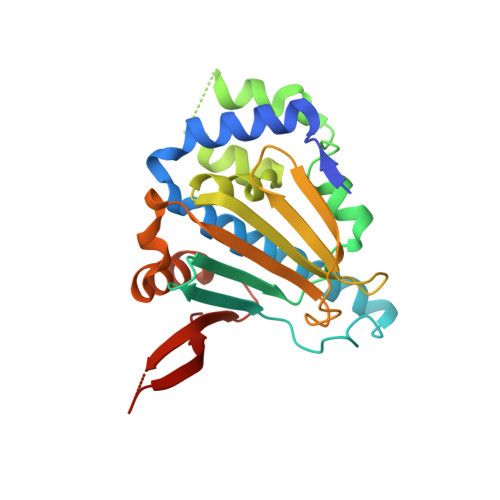Development of Glucose Regulated Protein 94-Selective Inhibitors Based on the BnIm and Radamide Scaffold.
Crowley, V.M., Khandelwal, A., Mishra, S., Stothert, A.R., Huard, D.J., Zhao, J., Muth, A., Duerfeldt, A.S., Kizziah, J.L., Lieberman, R.L., Dickey, C.A., Blagg, B.S.(2016) J Med Chem 59: 3471-3488
- PubMed: 27003516
- DOI: https://doi.org/10.1021/acs.jmedchem.6b00085
- Primary Citation of Related Structures:
5IN9 - PubMed Abstract:
Glucose regulated protein 94 (Grp94) is the endoplasmic reticulum resident of the heat shock protein 90 kDa (Hsp90) family of molecular chaperones. Grp94 associates with many proteins involved in cell adhesion and signaling, including integrins, Toll-like receptors, immunoglobulins, and mutant myocilin. Grp94 has been implicated as a target for several therapeutic areas including glaucoma, cancer metastasis, and multiple myeloma. While 85% identical to other Hsp90 isoforms, the N-terminal ATP-binding site of Grp94 possesses a unique hydrophobic pocket that was used to design isoform-selective inhibitors. Incorporation of a cis-amide bioisostere into the radamide scaffold led to development of the original Grp94-selective inhibitor, BnIm. Structure-activity relationship studies have now been performed on the aryl side chain of BnIm, which resulted in improved analogues that exhibit better potency and selectivity for Grp94. These analogues also manifest superior antimigratory activity in a metastasis model as well as enhanced mutant myocilin degradation in a glaucoma model compared to BnIm.
Organizational Affiliation:
Department of Medicinal Chemistry, The University of Kansas , 1251 Wescoe Hall Drive, Malott Hall 4070, Lawrence, Kansas 66045-7563, United States.

















